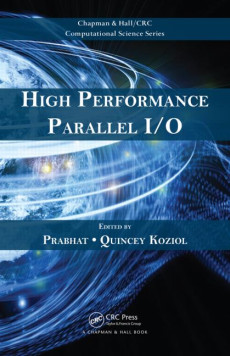A Comprehensive Look at High Performance Parallel I/O
Book Signing @ SC14 on Nov. 18, 5 p.m. in Booth 1939
November 10, 2014
Contact: Linda Vu, +1 510 495 2402, lvu@lbl.gov
In the 1990s, high performance computing (HPC) made a dramatic transition to massively parallel processors. As this model solidified over the next 20 years, supercomputing performance increased from gigaflops—billions of calculations per second—to petaflops—quadrillions of calculations per second—generating a tsunami of data along the way.
In this era of “big data,” high performance parallel I/O—the way disk drives efficiently read and write information on HPC systems—is extremely important. Yet the last book to summarize best practices in this area was written more than 10 years ago. To fill the void, Prabhat of the Lawrence Berkeley National Laboratory (Berkeley Lab) and Quincey Koziol of the HDF Group brought together leading practitioners, researchers, software architects, developers and scientists to contribute their insights for a new book called “High Performance Parallel I/O.”
The editors will be signing copies of the book and answering questions in the Department of Energy’s booth (#1939) during SC14 (Supercomputing Conference, 2014) on Tuesday, November 18, 5:15-6:00 p.m.
“This book provides a survey of the significant accomplishments in file systems, libraries and tools that have been developed for about a decade. These developments have now reached a state of relative maturity and are ripe for a treatment in book format,” writes Horst Simon, Deputy Director of Berkeley Lab, in the book’s forward. “I highly recommend this timely book for computational scientists and engineers.”
According to Prabhat, the book is divided into six parts. The first part explains how large-scale HPC facilities scope, configure, and operate systems, with an emphasis on choices of I/O hardware, middleware, and applications. It then traverses up the I/O software stack. The second part covers the file system layer and the third part discusses middleware and user-facing libraries.
Delving into real-world scientific applications that use the parallel I/O infrastructure, he notes that the fourth part presents case studies from particle-in-cell, stochastic, finite volume, and direct numerical simulations. The fifth part gives an overview of various profiling and benchmarking tools used by practitioners. The final part, addresses the implications of current trends in HPC on parallel I/O in the exascale world.
“This book is a soup to nuts collection of everything you need to know about high performance parallel I/O, from hardware all the way up into the software layers and future work,” says Koziol.
For more information about the book: http://www.crcpress.com/product/isbn/9781466582347
About the Editors:
Prabhat leads the NERSC Data and Analytics Services Group at Berkeley Lab. His main research interests include Big Data analytics, scientific data management, parallel I/O, HPC, and scientific visualization. He is also interested in atmospheric science and climate change.
Quincey Koziol is the director of core software development and HPC at The HDF Group, where he leads the HDF5 software project. His research interests include HPC, scientific data storage, and software engineering and management.
About NERSC and Berkeley Lab
The National Energy Research Scientific Computing Center (NERSC) is a U.S. Department of Energy Office of Science User Facility that serves as the primary high performance computing center for scientific research sponsored by the Office of Science. Located at Lawrence Berkeley National Laboratory, NERSC serves almost 10,000 scientists at national laboratories and universities researching a wide range of problems in climate, fusion energy, materials science, physics, chemistry, computational biology, and other disciplines. Berkeley Lab is a DOE national laboratory located in Berkeley, California. It conducts unclassified scientific research and is managed by the University of California for the U.S. Department of Energy. »Learn more about computing sciences at Berkeley Lab.










